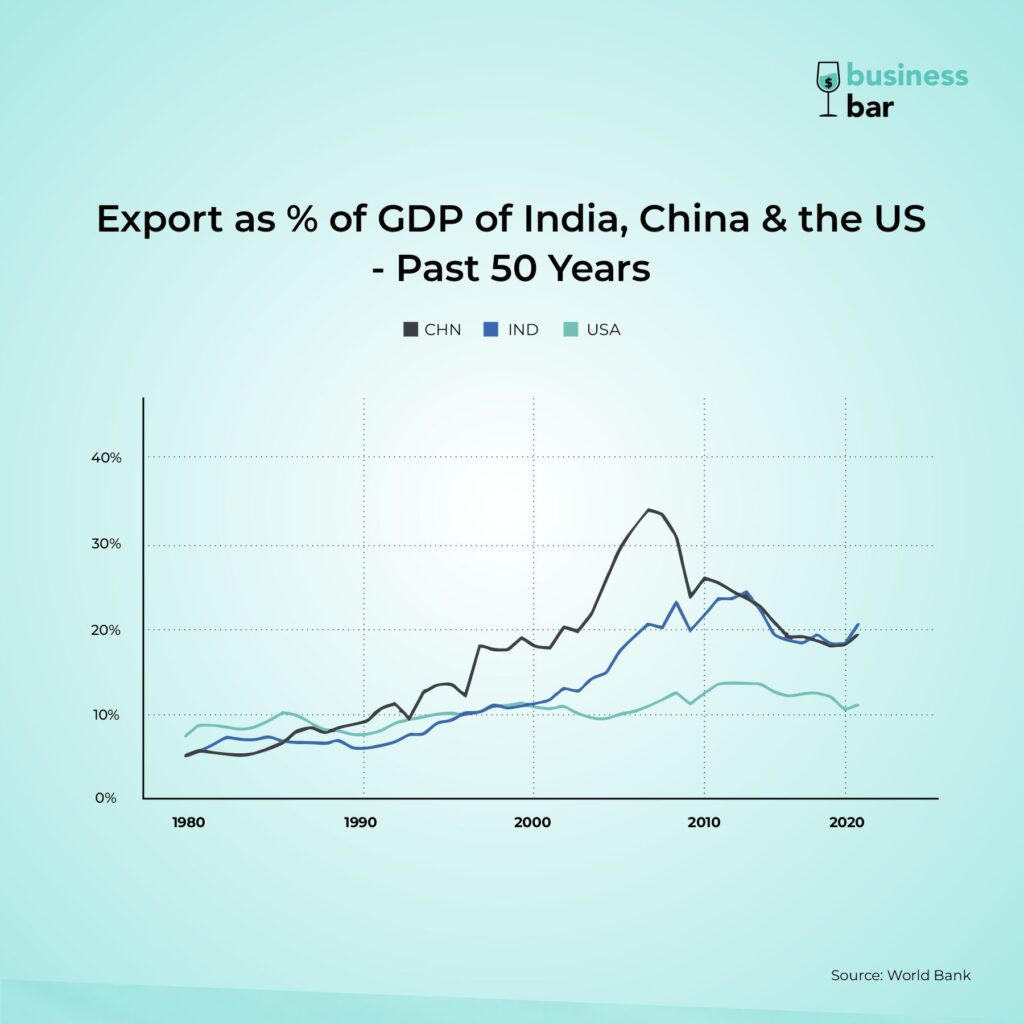
We live in a highly globalized world.
We have all read in the news and written in school essays the above sentence in some or other form.
China’s success can be attributed to being able to leverage its low-cost manufacturing and export goods around the world. India needs to follow the same playbook to climb the ranks in the largest economy list.
Another notion you probably have heard multiple times, more often recently.
Well, we are not going to deny any of them. Rather, allow us to show you how the numbers back the above narratives.
Apart from increased migration, cross-cultural influences, and increased cross-border communication, a case for globalization could be made just by looking at the screen in front of you. The device on which you are reading this is probably not made in your country. Not just that, but the hundreds of parts that went into making this device were designed and made in different countries.
What makes this possible? Answering ‘Globalization’ would mean beating around the same bush.
Exports – The ability to ship products and services overseas is what makes all this possible.
In 1960, the share of exports as % of Global GDP was just under 10%. 60 years later, today exports account for almost 25-30% of global GDP varying on different sources.
And mind you, the size of the global economy has increased over 60 times in these 60 years!
The Role of Exports in Global Dominance
“Exports are the lifeblood of any economy.”
– John F. Kennedy, 35th President of the United States
After the Second World War, a new world order was set – the US emerged as a clear winner. Not just militarily, but more strongly economically in the decades that followed.
The US dollar became the world’s default reserve currency as the US remained the largest exporter almost every year up until the 2000s.
But by the mid-2000s, the US lost the ‘largest exporting country’ throne to China. Of course, this doesn’t happen overnight.
Hence, let’s go back to 1980. Around that time India and China’s GDP was almost the same. The value of exports from the two countries was also in the same ballpark. Although China had a population of 1.5x as compared to India.
The two countries seemed on an equal footing on an absolute level and in fact, India’s prospects looked better on a per capita basis.
But what China was able to pull off from there in the next 3-4 decades is a feat unseen since the dawn of humanity.
With a poverty rate of almost 90% in 1981, they lifted around 800 million people out of poverty in the next 35 years. For context, if we double the population of the US which is the third largest population in the world, it’ll still be less than 800 million people.
The detailed version of how China did that is an altogether different story that has been beautifully put here – Journey of the Silicon Dragon.
But the shorter answer is, it opened its ability to produce goods at cheaper costs to the world.
Here’s a chart showing Exports as a % of GDP for India, China, and the US for the past 50 years.

One can see how Exports as % of GDP in China rose from the 1980s from below 10% to over 35% till the mid-2000s – right around the time it became the world’s largest exporter of goods and services.
This helped China grow its economy (GDP) at a phenomenal CAGR of over 12% for 4 decades from 1980 to 2020. The math might sound simple, but the consistency of execution at that scale is simply marvelous.
But what was once China’s strengths have now become its weaknesses.
It faces a trade war with its largest buyer – the US.
And secondly, the prosperity that came with growing exports can now become the very reason for the decline of its export competitiveness.
As GDP per capita rises, so do people’s living standards, minimum wage and cost of living. This coupled with geopolitical apprehension around China is now being seen as global manufacturers pulling out operations from China. They are either looking for new hubs in the developing world or increasing reshoring and near-shoring operations.
Make in India for the world
While one may argue that India also opened its borders economically to the world in 1991 with the new economic policy, the truth is it opened India opened more as a market for foreign sellers and investors than for Indian sellers to markets abroad. This was also because India wasn’t just ready to be a global manufacturer then.
Nevertheless, India has been able to steadily grow its exports over the years.
In fact, India’s growth in exports had a major contribution from the service sector, which grew at a 2% higher rate than merchandise exports did since 2001.

The country understands that it needs to ramp up exports and it has been reflected in the push the policies are providing. Bi-lateral trade agreements are improving, and the infrastructure to support exports is on the rise in the country providing a favorable trade environment.
Moreover, apart from services, special efforts are being taken to put India on the pedestal of a global manufacturer. India has an expanding skilled workforce that can very well support and contribute to the already growing domestic economy.
The country has set an ambitious aim to increase its exports from around $500B in 2020 to $2 Trillion (yes that’s a trillion with a T) by 2030, where both goods and services contribute $1T.
As the India External Affairs Minister Dr. S. Jaishankar has remarked that the world has to get ready for a new world order, one which isn’t bipolar like the US-Russia or the US-China axis, but rather a multipolar world where India has one of the multiple seats at the table of global decision making.
Time will tell whether the country reaches the $2T economic milestone in time or not, but India’s rising exports will definitely make its voice more firm at that table!
Written and Researched by Priyesh Zalani
